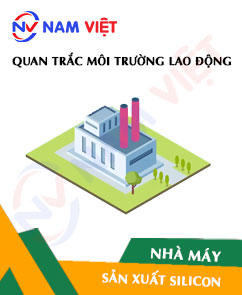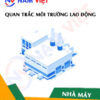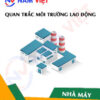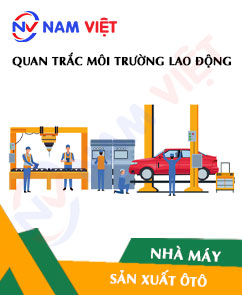Occupational environment monitoring of a silicone manufacturing factory
99,000 ₫
Note: The above price is calculated for one sample, prices may fluctuate depending on the area of the environment to be monitored and market movements. For more accurate price support, please refer to the price list or contact our consulting staff directly.
Monitoring the environment of a silicon manufacturing factory is a session of collecting, analyzing, and evaluating factors at the workplace that may be harmful to workers’ health.
Table of Contents
Toggle1. Overview of Silicon Manufacturing Factories
a. What is a silicon manufacturing factory?
A silicon manufacturing factory is a production facility where silicon products are processed and manufactured. Silicon is a chemical element with the symbol Si and atomic number 14 in the periodic table. It is an important material in many industries, including information technology, electronics, solar energy, and construction materials.
The silicon production process typically begins with extracting silicon crystals from natural sources, such as sand or quartzite. Then, the silicon crystals are processed and refined to produce silicon with desired quality and characteristics.

b. Production stages in a silicon manufacturing factory
The main stages in the silicon production process include:
- Washing and screening: Silicon raw materials are washed and screened to remove impurities and unwanted dust particles.
- Smelting process: Silicon is heated at high temperatures in an air or gas environment to remove impurities and convert it into crystalline form.
- Refining: Silicon crystals are refined and purified to remove impurities and increase purity levels.
- Measurement and quality control: Quality inspection is applied to ensure that the silicon products meet specific standards and requirements.
- Packing and transportation: Silicon is packaged and shipped to end customers, or further processed into other silicon products such as silicon wafers, display panels, solar modules, and other electronic components.

c. Types of machinery used in a silicon manufacturing factory
In a silicon manufacturing factory, various machines and equipment are used to carry out silicon processing and production. Some common machinery in the silicon industry include:
- Crystal furnaces: Used to heat silicon crystals at high temperatures in an air or gas environment to remove impurities and convert silicon into the desired crystalline form.
- Separation and sorting machines: Used to separate materials from silicon raw materials, remove impurities and dust, and sort silicon by purity and particle size.
- Pressing and rolling machines: Used in the production of silicon sheets and silicon wafers. Pressing machines compress and shape thick silicon sheets, while rolling machines thin and flatten the surface of silicon wafers.
- Chemical processing machines: Used to process and refine silicon through chemical processes such as neutralization, filtration, precipitation, and surface treatment.
- Quality inspection machines: Include devices and tools to inspect and evaluate the quality of silicon products, including purity testing, particle size measurement, flatness measurement, and cleanliness evaluation.
- Thermal processing equipment: Used to control and adjust temperature during silicon production, including furnaces, heaters, and temperature control devices.

d. Occupational diseases that may occur for workers in a silicon manufacturing factory
Workers in a silicon manufacturing factory may encounter some occupational diseases. Some common occupational diseases for workers in the silicon industry include:
- Respiratory diseases: Workers may be exposed to silicon dust during production, and prolonged inhalation can lead to respiratory problems such as pneumonia, asthma, and reduced lung function.
- Skin diseases: Long-term exposure to silicon can cause skin irritation and dermatitis, including itching, redness, inflammation, and eczema.
- Nervous system disorders: Certain chemicals used in silicon production may negatively affect the nervous system, causing symptoms such as headaches, fatigue, dizziness, and vision problems.
- Occupational accidents: Physical hazards in the work environment, such as running machinery, hot equipment, and heavy materials, may cause accidents such as cuts, crushing, punctures, and burns.
To prevent these occupational diseases, safety measures should be implemented, including using personal protective equipment (PPE) such as masks, gloves, and safety goggles, ensuring a ventilated working environment, operating machinery safely, training staff on occupational safety and chemical management, and complying with environmental and health regulations.

e. Common silicon products on the market
There are many common silicon products widely used in various industries. Some major products include:
- Microcontrollers and electronic components: Silicon is used to manufacture microchips and electronic components such as processors, integrated circuits, transistors, and other electronic devices.
- Solar modules: Silicon has photovoltaic properties, so it is used to manufacture solar panels and modules to convert solar energy into electricity.
- Lithium-ion batteries: Some components of lithium-ion batteries, such as silicon tubes, are also made from silicon.
- Silicone adhesives: Widely used in construction and industrial applications for bonding, sealing, and insulating surfaces. They are heat-resistant, waterproof, and highly durable.
- Anti-magnetic products: Silicon is used to manufacture anti-magnetic products such as magnetic tapes, pads, coatings, and anti-magnetic casings.
- Personal protective and medical products: Silicon is used to produce PPE such as silicone masks, gloves, and ear protection. It is also used in medical applications to make silicone tubing, valves, and other medical devices.
- Enamel coating materials: Silicon is used in ceramics and tiles to create glossy surfaces and protect surfaces.
- Household products: Silicon is also used to make kitchenware, buttons, mats, pipes, and other heat-resistant household items.

2. Overview of Occupational Environmental Monitoring Services
a. What is occupational environmental monitoring in a silicon manufacturing factory?
Occupational environmental monitoring (or labor environment measurement) in a silicon manufacturing factory involves collecting, assessing, and analyzing measurements of occupational environmental factors to implement timely measures, minimize environmental hazards to workers’ health, and prevent occupational diseases. Occupational environmental monitoring is mandatory for silicon manufacturing factories.
Occupational environmental monitoring plays a crucial role in protecting and enhancing workers’ health, as employees are the main resource generating profit for the company. Workers regularly exposed to risks exceeding permissible limits may suffer health impacts and develop occupational diseases.
REGISTER FOR OCCUPATIONAL ENVIRONMENT MONITORING SERVICE
b. Nam Viet’s occupational environmental monitoring program
Nam Viet’s occupational environmental monitoring program is developed by monitoring engineers in the field of occupational safety and environmental protection. To ensure workers’ health and safety, the program uses modern measurement methods to monitor air quality, water, microclimate, physical factors, and dust in the workplace. This program is essential for maintaining a safe working environment and protecting workers’ health.
Additionally, Nam Viet’s program contributes to research and development of new solutions to improve workplace environmental quality. With the dedication and professionalism of its monitoring experts, Nam Viet’s exclusive program has become a breakthrough in occupational safety and environmental management in Vietnam.

c. Standardization in occupational environment measurement procedures
Standardization in Nam Viet’s occupational environment measurement procedures is vital to ensure the accuracy and reliability of results. The program applies recognized standards and procedures from the Ho Chi Minh City Department of Health. This ensures that the collected data can be reliably used to assess the workplace environment and make decisions to improve conditions and protect workers’ health.
These standardized procedures also guarantee that measurements are conducted by highly skilled monitoring specialists with years of experience, giving managers and experts confidence in the results from An Toàn Nam Việt and enabling precise, valuable decisions in protecting workers’ health and the environment.
By applying standardized measurement procedures, Nam Viet demonstrates its commitment to providing a safe working environment and protecting workers’ health while contributing to the improvement of occupational safety and environmental management in Vietnam.
d. Reporting results of environmental monitoring in silicon manufacturing factories
Environmental monitoring results are prepared according to Form No. 04, Appendix III issued with Decree 44/2016/ND-CP and prepared in two copies: one sent to the contracting workplace and one retained by the monitoring organization.
The retention period for occupational environmental monitoring results is unlimited according to legal regulations.

e. Frequency of occupational environmental monitoring as per law
According to Clause 2 of Article 18, Law on Occupational Safety and Health 84/2015/QH13, employers must organize occupational environment monitoring to assess harmful factors at least once a year.
f. Deadline for submitting occupational environmental monitoring reports as per law
The deadline is before December 31 each year. Enterprises in mandatory production facilities must submit occupational environmental monitoring reports to the local Department of Health where the business is headquartered and where employees work.
Whenever there are changes in technology, production processes, or during renovations/upgrades that may generate new harmful factors affecting workers’ health, enterprises must update occupational hygiene records regarding the harmful factors requiring monitoring.
g. Penalties for violations of occupational environmental monitoring by employers
According to Article 27 of Decree No. 12/2022/ND-CP dated January 17, 2022, on administrative penalties in labor, social insurance, and Vietnamese employees working abroad under contracts:
- Clause 2: Fines ranging from VND 2,000,000 – 5,000,000 for employers who do not publicly disclose monitoring results to workers at the workplace and in areas where hazardous factors are evaluated immediately after results are available.
- Clause 3: Fines ranging from VND 20,000,000 – 40,000,000 for employers who fail to conduct occupational environmental monitoring to control health risks to workers as required by law.
- Clause 4: Fines ranging from VND 40,000,000 – 60,000,000 for employers who cooperate with monitoring organizations to commit fraud in environmental monitoring activities without reaching criminal liability.
3. Harmful Environmental Factors for Workers in Silicon Manufacturing Factories
Workers in silicon manufacturing factories may be exposed to harmful environmental factors. Some of the main factors include:
- Silicon dust: The production and processing of silicon can generate silicon dust. Long-term inhalation of silicon dust can cause respiratory problems such as pneumonia, asthma, and reduced lung function.
- Chemicals: During silicon production, certain chemicals such as acids, heavy metal compounds, and additives may be used. Exposure to these chemicals can cause skin irritation, respiratory issues, and toxic effects on various organs.
- Temperature and pressure: Some silicon production processes involve high temperature and pressure, which can create unsafe working conditions and pose risks to workers.
- Noise: Machinery and equipment in silicon factories can produce high levels of noise, affecting hearing and causing stress and fatigue for workers.
- Electromagnetic exposure: Electronic devices and systems used in silicon production can generate electromagnetic fields, which may pose health and safety risks for workers.
- Occupational accidents: In a working environment like a silicon factory, there is a risk of accidents, including hazards from operating machinery, heavy materials, cutting tools, and procedures that may cause injuries or other incidents.
REGISTER FOR OCCUPATIONAL ENVIRONMENT MONITORING SERVICE
4. Measures to Improve the Work Environment in Silicon Manufacturing Factories
To improve the work environment in silicon factories and protect workers’ health, the following measures can be applied:
- Dust management: Provide effective dust extraction systems to reduce silicon dust in the air. Ensure regular industrial hygiene and use dust control measures such as water spraying, directional dust collection systems, and personal protective equipment like dust masks.
- Ensure proper ventilation: Maintain efficient ventilation systems to remove toxic gases and provide clean and fresh air for workers.
- Chemical management: Ensure safe storage, handling, and transportation of chemicals while complying with relevant regulations. Train employees on safety measures when working with hazardous chemicals and provide appropriate personal protective equipment.
- Noise control: Implement noise control measures, including isolating machinery, using sound barriers, and providing ear protection to reduce noise to safe levels for workers.
- Safety training and supervision: Train workers on occupational safety, accident prevention, and proper use of safety equipment. Conduct regular safety inspections and monitor compliance with safety rules.
- Waste management: Manage waste from silicon production efficiently and comply with environmental regulations to reduce negative impacts on the environment.
- Health monitoring: Conduct regular health checks to detect early health issues related to working in silicon factories.
- Promote safety awareness: Foster a work environment that enhances awareness of safety and health, encourage workers to report safety issues, and contribute to improving the work environment.
- Regularly conduct occupational environment monitoring in factories to collect and analyze harmful factors affecting workers, then adjust to reduce risks and prevent occupational diseases.
5. Benefits of Regular Monitoring in Silicon Manufacturing Factories
An Toàn Nam Việt provides businesses with great benefits when using occupational environment monitoring services in accordance with Decree 44/2016/NĐ-CP on the management and control of harmful factors in the work environment affecting employees.
- Businesses can proactively monitor harmful factors in factories.
- Receive recommendations on measures to reduce harmful factors and improve the work environment quality.
- Indirectly protect human resources, the key factor in business development.
- Reduce the impact of occupational diseases on workers’ health, thereby minimizing future treatment costs.
- Improved worker health leads to better product quality and ensures stable production output.
- Comply with labor safety laws, avoiding legal risks.
- Enhance credibility and professionalism in all aspects, raising the company’s brand value.
Nam Viet’s environmental monitoring service is a solution to minimize occupational disease risks, contributing to a clean and high-quality work environment.

6. Nationwide Occupational Environment Monitoring Center
Nam Viet Occupational Environment Monitoring Center is a professional unit specializing in monitoring and measuring workplace environmental quality throughout all provinces of Vietnam. With an experienced team of environmental monitoring specialists, the center uses modern measuring equipment to ensure accuracy and reliability.
In addition to providing monitoring services, the center assists clients in planning, managing, and following up on occupational environment issues. With the motto “customer-centered,” the center prioritizes client satisfaction, meets all client needs, and commits to providing the best solutions.
REGISTER FOR OCCUPATIONAL ENVIRONMENT MONITORING SERVICE
With investments in technology, equipment, and human resources, Nam Viet’s monitoring center has become a reputable unit in occupational environment monitoring in Ho Chi Minh City, with the following goals:
- We value brand reputation and the quality of our service products.
- We provide clients with the best and most suitable solutions.
- With a team of experienced Masters and Engineers committed to protecting the environment and benefiting businesses.
- Clients of Nam Viet Environmental Monitoring will receive professional services from experts in the field, as well as the best cost advantages.
The occupational environment monitoring process at Nam Viet includes the following steps:
- Before monitoring, ensure all equipment is calibrated and adjusted according to legal regulations.
- Carry out the monitoring process as committed to the Department of Health.
- Report accurate monitoring results to employers.
- If monitoring results indicate unsafe conditions for workers, Nam Viet will provide corrective solutions, and the factory will implement:
- Implement measures to improve working conditions, minimizing harmful factors and preventing occupational diseases.
- Organize medical check-ups to detect occupational and work-related illnesses early for employees in unsafe work environments.
- Provide compensation in kind for workers according to labor law regulations.

7. Occupational Environment Monitoring Price List
To help businesses conduct professional and effective occupational environment monitoring, Nam Viet provides clients with a detailed and reasonably priced service price list.
- Our price list provides detailed information on the costs of all monitoring services, including transportation, measurement, analysis, and reporting. Clients can be confident in the accuracy and reliability of the monitoring reports provided.
- We are committed to offering competitive and reasonable prices while providing prompt and professional consultation on any service-related inquiries.
- With Nam Viet’s price list, clients can easily select services that best meet their needs. We guarantee maximum satisfaction with professional service quality.
No comments yet












Review Occupational environment monitoring of a silicone manufacturing factory
There are no reviews yet.